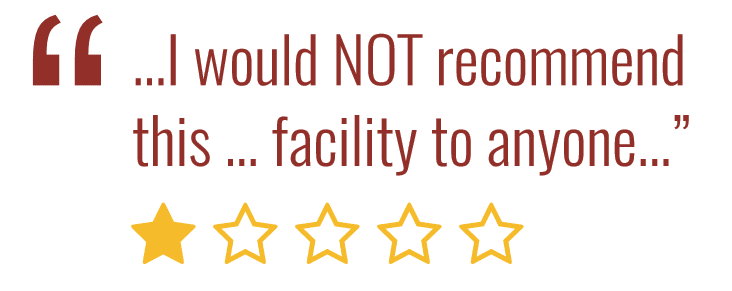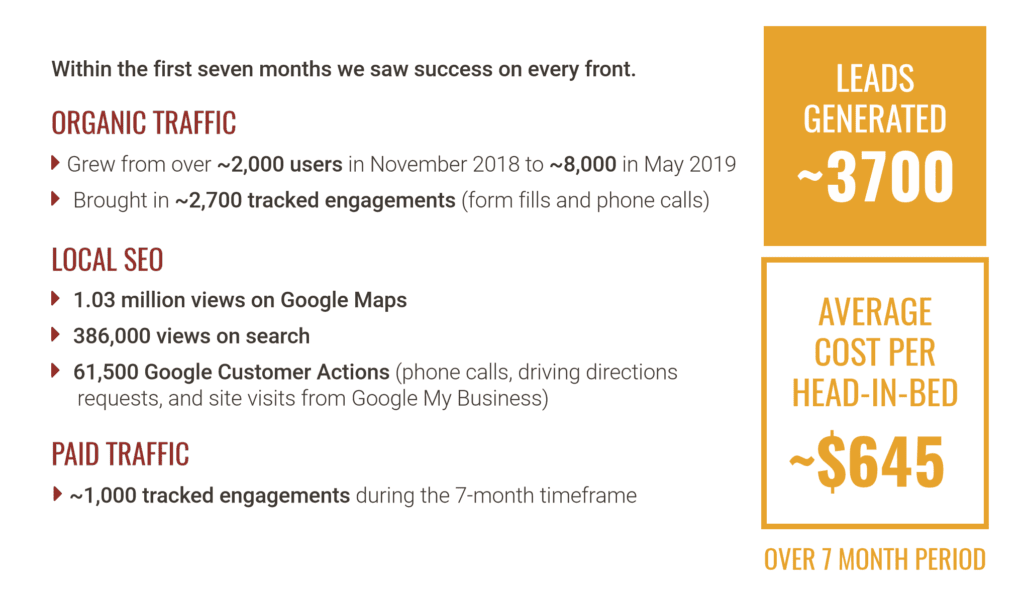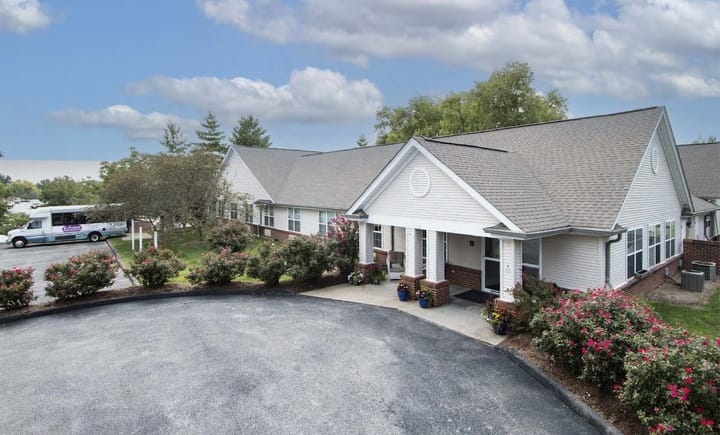CASE STUDY
How a Multi-Channel Digital Marketing Strategy Decreased Cost Per Lead by 81%
See how a thorough digital marketing strategy led to an 81% decrease in cost per acquisition for a major senior living facility management firm
THE RESULTS
Desire to generate cost-effective leads after large acquisition costs
Implement a robust marketing plan with an emphasis on lead tracking
ROI 4x higher than routing through listing websites
In 2018, the organization agreed to purchase 36 under-performing properties from one of the largest senior care providers in the country.
Before the ink was dry on the paperwork, the enormity of the challenge that lay ahead had begun to take root.
The properties that comprised the agreement were populated with disillusioned staff, and their physical state, characterized in part by outdated design, had long been ravaged by deterioration because of subpar management.
There was a massive string of bad reviews across multiple platforms.


Some of the more choice reviews included language like “…I would NOT recommend this … facility to anyone…” and
“Worst place ever,” just to name a few.
Add it all up, there was a lot of work to be done. The only solace was that the properties had been acquired at a discount.
The first order of business was stamping these new properties with the seal of the new brand, and each location needed extensive digital touch-ups to make them more appealing to potential residents.
Each new property desperately needed improved occupancy to make the huge investment worthwhile, but that wasn’t going to happen without an entirely revamped approach to generating the leads needed to spur that growth.
The Problem
At the time of the acquisition of the new properties, each community was using third-party listing sites as its primary means of reaching prospective residents online.
A third-party senior living directory site makes money by stipulating within its contract that any organization that uses its services is beholden to paying that directory a fee for every lead that becomes a new resident at that organization’s facility.
Oftentimes, this fee may be upwards of nearly two times the cost of one month’s rent at the facility.
This process is not atypical of what happens after the acquisition of a head in a bed, so to speak, but what appeal does a stipulation like that possess, particularly if it forces the senior living organization to pay the listing site a fee that many (if not all) would consider exorbitant?
That answer is, not much at all. That is, unless, the organization in question does not have the necessary resources or guidance to build out its own internal marketing plan — one that operates either in unison with or in place of, an agreement with a listing site.
Listing sites typically charge 1.5x month’s rent for every head in bed they have a hand in. That can be anywhere between a few thousand dollars to over $12,000 per new resident!
For many senior living organizations, including our client, the easy way out of this conundrum is to throw your hands up and simply concede that the pain of eating the cost demanded by the listing site is less excruciating than the thought of digging in to conceptualize and build an internal marketing strategy that offers independence from third parties.
Our client could have easily done that and doubled down on the efforts of previous ownership, especially when you consider the possibility that some low-hanging fruit dangled by listing sites may have ignited a turnaround of the under-performing properties they had just purchased.
In our discussions with the client, our team suggested the best approach for predictable and profitable growth was to invest in their own digital marketing efforts, which would eventually weaken the dependency on third-parties for lead generation.
It was made clear that this route would not be the shortest, but ultimately, it saved our client money and provided the entire organizational structure, namely its marketing department, with a sense of freedom and autonomy that had been lacking for years.
The Solution
Our paid search team introduced Bing as a new avenue for paid search in January 2024, to start the new year.
Our team noticed that Bing Ads offered success for other clients in different verticals. We hoped that success would transfer to Fundraising Brick with the right strategy and implementation. Specifically, we saw Bing Ads as an avenue for success because one struggle for Fundraising Brick was the higher cost per lead on Google Ads… which would be less of an issue on Bing Ads, making Bing the best place to test our paid search strategy.
Bing Ads are not as mainstream as Google Ads because the vast majority of searchers use Google, not Bing. In fact, Bing only holds just over 7% of search engine market share in the United States, Google holds a whopping 87%. Most advertisers see this discrepancy and drop Bing Ads as a viable route for leads.
We saw past this discrepancy to see opportunity. And it’s because we understood our target audience. Our target audience leans older, has more disposable income, and uses Microsoft applications. These 3 characteristics overlap with Bing’s typical users, who are often older, wealthier, and prefer Microsoft compared to Google users. Even better, because there are less advertisers on Bing Ads, we had less competition and lower costs per lead.
The best part of this strategy? We didn’t need to ask the client for more money for a Bing campaign. We just reallocated $500 from our $2500 Google budget to Bing, and saw quick growth in leads from the get-go. Not only could we generate more leads from our budget, but we could also generate them at a lower cost per click (CPC).
Once we began to see growth (139% increase in engagements, to be precise), we decided to move more of the budget from Google to Bing. The leads just kept growing.
Our Comprehensive Digital Marketing Strategy Consisted Of The Following Four Pillars:
Lead Attribution and Tracking
We’ll cover each of these bullets in more detail, but it’s important to note that, together, they were employed to accomplish three very important objectives:
- Increase the number of overall leads
- Improve overall lead quality (so as to lower the cost per acquisition of a new resident)
- Completely eliminate dependency upon third-party listing sites
As mentioned before, as it was explained to the client, this approach would not be a bandaid for the ailing communities; it would not be a snatch-and-grab approach founded on the promise of instant results.
That being said, we wanted to make sure that the comprehensive plan, layered to cover each of the unique results sections of search engines, would be segmented to also sustainably produce quality leads, including early in the process, with the long-term focus being to lower the cost per lead incrementally over time.
Here’s how we made that happen:
Search Engine Optimization
A strictly long-term solution, the viability of which over extended periods of time cannot be overstated, SEO should be the epicenter of any well-rounded digital marketing game plan. For this client in particular, it was treated exactly as such.
The goal was to optimize the client’s website so that it would rank well organically for a large assortment of crucial keyword searches. These keywords would represent the searches performed on behalf of interested prospects across all stages of the ever-changing decision-making process.
We achieved this by attacking the three elements of successful SEO: technical, content, authority.
The first step was cleaning up any technical errors that would either outright prevent Google and other search engines from indexing the site’s pages — or make it much too difficult to do so.
This acted as a mandatory foundation to the second step, which was to replace the site’s existing content with that which was engaging and answered the questions we and the client knew prospects would arm themselves with. This type of content is also something search engines crave.
Lastly, we needed to embark on a meticulous link-building campaign. These efforts would identify quality sources around the Web from which to link back to the organization’s website. As more of these sources were accrued over time, the more authority the site would portray to Google — and the keyword rankings would follow.
Local SEO
As its name explicitly implies, this process was input in place to optimize the organization’s marketing efforts to be seen for hyperlocal searches. If you think about it, local SEO can hold a unique importance when it comes to the senior living space, where children of prospective residents, located hundreds of miles away, may very well search for a community local to their parent’s location.
Think of terms like “senior living near me,” “local retirement communities,” and “where can I find an assisted living facility nearby?”
Local SEO can produce more immediate traffic, through platforms such as Google My Business and Bing Places, and we were able to leverage them and others, including tools to make sure the organization’s name, address, and phone (NAP) — a main signal of trust when it comes to local SEO — was consistent across the Web ecosystem.
Paid Search Ads
Paid search ads were used to most closely mimic the quick wins that were previously being relied upon by third-party listings to produce.
Less of a viable advertising method over time, more so in terms of cost-effectiveness rather than overall effectiveness, paid search ads work off an auction-based system that is subject to more fluctuations in cost than the stock market.
However, this can often be overlooked by their ability to achieve premium exposure near or at the top of search engine results, therefore increasing the likelihood of a click, website visit, and (possible) lead.
The goal for us was to arm the organization with a good number of leads early, albeit at what might be a cost higher than desired, and then continue to do so as time went on at a lower price per lead, which can happen thanks to the built-in advantages of paid ads that tend to reward successful campaigns with a lower cost for each click.
Proper Tracking & Attribution
Leveraging the right channels to reliably generate leads at a cost that diminishes with time was the main idea, but any marketing plan worth its weight is not complete unless it also includes transparent tracking.
This allows for attribution that is clear and definable, making it infinitely easier to implement changes on the fly and allocate funds to channels that are more successful than others.
We had to show the client that leads produced by our plan would be delivered at an average cost lower than those that were attributed to third-party listings.
Especially considering the properties that were acquired by our client had failed to track the exact source of each lead, it was even more crucial that we insist upon including transparent tracking and attribution as part of our efforts.
Lead Tracking / Source Attribution Tools Used:
Phone Call Tracking: Having the capability to measure the quality of all incoming calls was imperative.
Given the high volume of searches being performed for terms related to senior care, the opportunity for equally high call volume was apparent. We were confident the initiatives we had put in place for the client would put their site in a position to capitalize on this opportunity, but we needed to be able to peek behind the curtain.
The client needed to know what was happening — what was being said — on every phone call, each of which could be recorded in full.
This was achieved by purchasing a list of tracking phone numbers that would be implemented across all marketing channels. Each tracking number would be labeled to reflect the marketing channel for which it would be used, making it 100% transparent to the client where every call was coming from.
This level of in-depth knowledge could, in effect, crystallize the entire resident recruitment process for the client by allowing them to do the following:
- Identify and separate cold, warm, and hot leads
- Benefit from detailed insights to determine the success of different channels
- Use varying quality of calls to spot and improve weaknesses in internal sales processes
Not long after our marketing plan was set in motion, we discovered that approximately 10 percent of all tracked calls originated from what was determined to be warm leads. But more on that later.
Web Form Tracking: Those needing post-retirement care — whether the search is being done for the person actual needing the care or by his or her children — are sure to have plenty of questions, and it’s inevitable that at least a small percentage of them will not want to reach for a phone to jumpstart the conversation with a community.
For some, the most attractive option is to fill out a form on a site and then wait for a callback.
As such, we knew that proper tracking and attribution of all web form completions on the client’s site would be every bit as important as phone calls.
Every form, from the standard contact version to something more detailed, was properly labeled and would allow us to identify the traffic source of each successful submission, as well as the name, email address, and phone number of the submitter.
Gathering email addresses from these forms provided the client with a distinct advantage that could not be provided — at least not immediately — by call tracking. With every successful form submission, the person’s email address could be funneled into a sales pipeline that the client’s sales team could then use to nurture over time.
Although perhaps unsurprisingly, web forms were generated at a significantly lower rate than phone calls, they did produce a higher ratio of warm leads. Once we had filtered out all form submissions that represented solicitation attempts, we found that more than 75 percent of all valid submissions originated from warm leads.
The Result
At the time of launch, we were performing services for 20 of the client’s community locations as they slowly cemented operational control of the 36 newly-acquired locations.
While the proper tracking and attribution processes we implemented could tell us how many warm leads came from a particular channel, it wouldn’t provide us the insights to know where the actual acquisition of a new resident could be attributed — at least not without a little help from the client.
The client informed us that their sales team, historically, closed about 10 percent of all prospects generated for their locations into paying residents.
Knowing this close rate helped us finalize a model that accurately showed how much it cost to acquire a new resident to measure against the cost to purchase a new opportunity from one of the lead generation websites. We used the sales team’s close rate to calculate the average cost per conversion. During the course of the first seven months of activity, this figure remained relatively steady.

In the final month of this study, the average cost per new resident was $645.
Previously, depending upon the third-party website from which the client received the lead, that average cost typically ranged between $3,000 – 4,000 per new resident.
This is a decrease of as much as ~81% per acquisition.
Erring on the side of comparing conservatively, that means the new marketing infrastructure was, in some cases, up to five times more efficient than purchasing leads from third-party listing websites.
This dramatic difference was only possible because we implemented a diversified marketing strategy and closely monitored the results. And the efforts resulted in a tangible decrease in cost-per-acquisition that would ultimately prove to be scalable.
Early on, while the cost per head-in-bed remained relatively linear, the number of leads each community received steadily increased over time.
The first 30 days, a total of 33 closed leads were generated among those initial 20 senior living communities, and each location received an average of about 1.5 new closed leads per month.
Furthermore, the number of leads generated per month increased incrementally from November 2018 to April 2019, showing MoM gains by as much as ~25 percent.
The young stages of the revamped marketing strategy had exceeded even our expectations, and we had not even touched any of the newly-acquired properties.
But there was still plenty of work to be done.
By the time May had rolled around, a total of 33 locations were on-board, with the new arrivals receiving the same marketing treatment as those first 20. Despite the added volume, confidence was high that we could produce sustainable results for all communications by applying what we had learned during those first five-plus months.
In May, a total of 85 closed leads were generated across the 33 different communities — a total that now included several of the underperforming properties — meaning each community was receiving about 2.5 more residents each month.
During this early stage, we found that paid search ads were producing a considerable bulk of the leads. However, as the site began to accrue more authority with Google due to the link-building campaign, organic traffic began to quickly catch up as the most successful channel.
The Conclusion
When the relationship commenced, the client already owned and operated several communities that, like all senior living properties, needed increased occupancy. But the primary concern all along was justifying the expense of buying the underperforming properties by quickly turning things around for each one
Our marketing strategy focused on executing a long-term lead-generation plan that was applicable to each property — and one that the client could own and expand for years to come, completely free of any third-party interference.
The key to this success was our clients’ ability to understand exactly where the leads were coming from and to precisely calculate how much money each channel was spending to produce each lead.
By closely monitoring the performance of the dollars being invested in your marketing efforts, you can develop insights that separate you from your competition.
At Digital Strike, we help clients establish their digital presence on their terms. Whether you need a PPC campaign, a flood of fresh SEO content, or a complete marketing campaign, we’ve got the chops to deliver that to you
“We were shocked to the cost per lead drop in just six months. We’re saving so much money in the long run without having to pay lead generation sites for our own leads.”
– CMO, Senior Living Community Group
There's more where that came from:
Fundraising Brick

Fundraising, Nonprofit
13 Months
Lead Generation
Paid Search
With a few simple tweaks of a budget, we opened up a new avenue for growth in paid search, resulting in leads growing over 330% for our client in just a few short months.
Hyper Fiber

Fiber Internet Provider
12 Months
Boost Organic Visibility
Organic SEO
Through a strategic, SEO-focused digital marketing campaign complemented by targeted ads, we grew HyperFiber’s keyword rankings from just 2 to 1,156 in one year, making organic search the largest contributor to new customer orders.
St. Andrew's

Senior Living
12 Months
Lead Generation
Digital Marketing Mix
Through a multi-pronged digital marketing mix and full SEO campaign, we drove a 45% increase in organic traffic and a 70% growth in first-page keyword rankings, helping St. Andrew’s win valuable leads directly rather than relying on third-party sites.